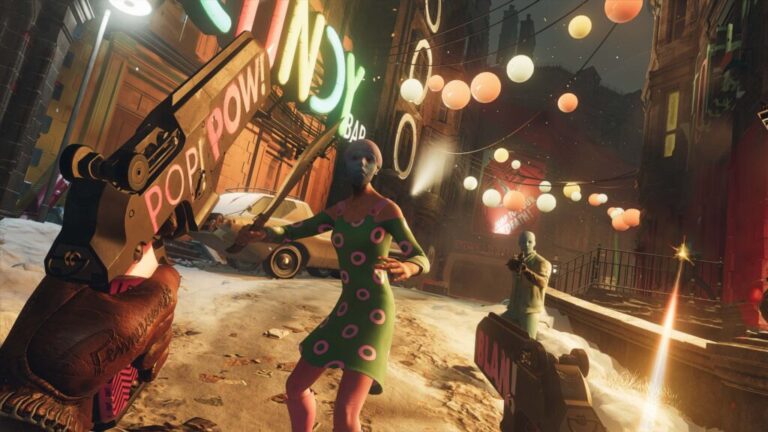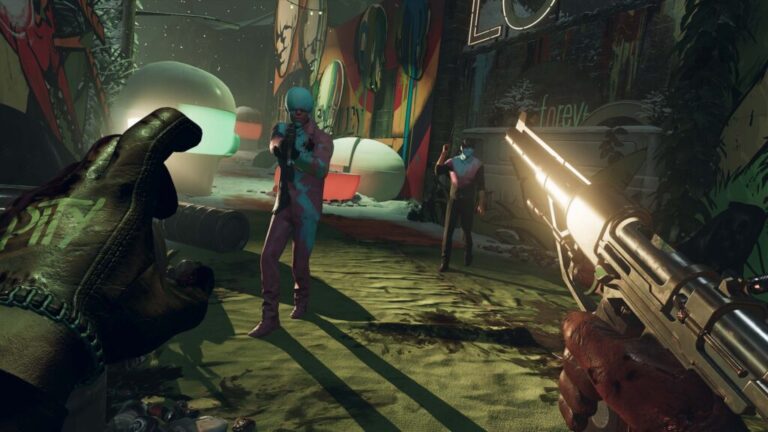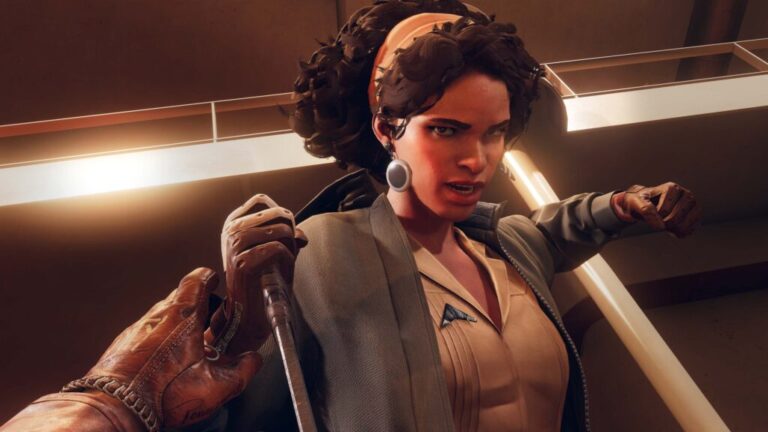An arduous start and AI gripes notwithstanding, Deathloop is a mind-bending sandbox with a compelling gameplay loop.
Deathloop review: Groundhog prey
Deathloop quick verdict
If you’ve ever been intimidated by Arkane Studios’ previous works—Dishonored, Dishonored 2 and/or Prey—Deathloop is a lot kinder in its player handholding, even if there’s still some great depth at play here. The first few hours act as a guided tutorial, which quickly outstays its welcome with an inelegant bombarding of text-based tips, but Deathloop comes into its own when it fully opens up afterwards.
That said, the AI is particularly dim and enemy design is sometimes confusing to the point where you can’t tell which way they’re facing, and I had a few progress-impacting crashes that were concerning. But these immersion taint-ers ultimately help to highlight the addictive gameplay loop that’s at the heart of Deathloop, whether you’re cracking the main mystery, solving the plentiful side-quest puzzles, or simply exploring this fascinating and fully realised world.
- Addictive gameplay loop
- Gratifying time-loop puzzling
- Great sense of humour
- Incredible world-building
- Text-bombardment tutorials
- Recycled Dishonored powers
- AI really isn’t switched on
- Sometimes confusing enemy design
Deathloop review
Arkane Studios has made a name for itself by forging beautifully realised game worlds where player choice is at the heart of the gameplay loop. For some, this can be intimidating, particularly when you factor in the more RPG-like moral choices of the Dishonored and Prey games.
As a big fan of both of those earlier Arkane games, I’ve been champing at the bit to see what the studio has been cooking up with Deathloop. Thankfully, Deathloop is mostly worth the wait.
The basic pitch is you play as Colt Vahn, a capable killer who’s stuck in a daily repeating loop on an odd island called Blackreef, which is dripping with 1960s influences. When the game starts, Colt’s lack of knowledge about what’s going on mirrors the player’s journey, but soon both Colt and player are retaining knowledge between many, many loops.
To break the titular death-loop, Colt quickly learns he has to kill eight Visionaries in the same day, all of whom are more readily accessible in one of four island hubs at one of four times of day. As if that wasn’t tricky enough, Colt is being actively hunted by one of the Visionaries, Julianna, who also appears to be retaining memories across time loops.
This setup makes the gameplay loop a bloody puzzle of getting as many Visionaries as possible in a particular place at a certain time so you can whack all of them before the day resets. Despite a flashy opening and plenty of unexpected humour and personality from the constant over-the-radio bickering between Colt and Julianna, the first few hours of Deathloop are a slog.

It’s hard to not feel like the tutorial-heavy opening hours—yes, hours of the training wheels on—of Deathloop are an overcompensation for what may have been seen as the ‘problems’ of Arkane’s underperforming previous games, Dishonored 2 and Prey. Namely, that the depth of gameplay mechanics is great for savvy players but may be intimidating for those unaccustomed to such freedoms, even if those earlier Arkane games can be played in fixed ways: specifically, hard stealth or all-out aggressive.
Ironically, this player hand-holding in Deathloop leads to too much information being dumped—inelegantly via walls of text as well—so retaining these insights proves tricky later on. I’ve had discussions with other reviewers and we all missed something that the other retained or learnt later, sometimes down to core basics.
For me, I got stuck at one point late in the campaign because I didn’t know I could hack open barred doors. On the topic of hacking, another mentioned they didn’t know they could hack security cameras until a few hours in. And given the by-design repetitive nature of Deathloop—after all, the concept is that this is Groundhog Day with assassinations—this can add to the overall frustration, particularly when you get stuck.
Arkane’s solution is, again, more walls of text, with a dedicated tutorials section in the menu, which is stuffed with loads of information. It’s a shame because the biggest Deathloop disclaimer is to persevere with the opening hours until the handholding stops. After that, things open up for you to crack the overarching puzzles of how to score eight kills in four hubs across four different times of day. Not all targets are conveniently located in the same location, either, so it’s not a case of stacking two kills per location/time zone.
You can, if you want to ‘hard mode’ it up a bit, opt to not track the questlines of the different Visionaries, leaving it up to you to figure things out with a heavy dose of experimentation and area exploration. A big part of the game is finding audio recordings and notes, which are sometimes a pain to spot amid often cluttered spaces. These unlock clues of what to do next and Colt, handily, offers vocal feedback for bigger clues, plus there are smaller end-of-area cinematic recaps when you sufficiently progress a Visionary’s questline.

Alternatively, you can activate the markers and it’s a more guided approach, which is handy when you get stuck. It also means that those playing in smaller sessions (rather than the four hours-long sessions I played it in) can still feel as though they’re progressing the story. That said, more patient players will be rewarded with a world stuffed with secrets and revelations, and it’s made all the richer because of how different areas feel at different times of day.
When it comes down to the business of killing, business is… decent. Gunplay is satisfying, particularly with the beefier guns, and there’s a colour-coded weapon-tier system (as well as mods later in the game) to help differentiate what otherwise would have felt like quite a small arsenal. But what drags things down is how dumb the enemy AI is, which tends to make stealth play laughably easy. Enemy peripheral vision is basically non-existent, and goons tend to have selective hearing, so you can often noisily kill one right next to another one that remains oblivious.
In fairness, even basic enemies can hit pretty hard with the right weapons if they get the drop on you. Additionally, there are definitely times where the game world packed with items—which is admittedly great for world building and making it feel lived in—makes it harder to track enemies, particularly those attacking from afar. On this point, while the basic enemies have some great overly colourful designs, it also impacts the readability (particularly at range) for even basic things like which way they’re facing. There aren’t any difficulty modes, though, so it’s easy enough to exploit the AI in these instances or take advantage of Colt’s ever-growing arsenal of passive and active abilities.
Ultimately, it’s best to think of the basic enemies as playthings, and Arkane actively encourages you to play with your prey. And why not: when you know you’re going to restart a loop, there’s no reason to not test out that new ability or gun to see if you find a new favourite. While the prospect of repeating the same tasks and loops over and over could quickly grow stale, Deathloop keeps things fresh by constantly dangling story-advancing, gameplay-evolving carrots.
It may be the same four places, but these environments can sometimes drastically change at different times of day, and there are also flow-on effects for, say, something you do in the morning that impacts areas later in the day. This isn’t always positive, either, and I quickly treated replaying an area as an opportunity to search for new approaches to tackling familiar scenarios. When you are trying to main-path it back to try something, going loud is as viable as it is forgiving in terms of how enemy alert states are relatively restricted to a specific smallish area.

The exception to this is a particular enemy type that can call for reinforcements, and while this can lead to frantic gunfights, if you’re unlucky like I was on a couple of occasions, you’ll be catching your breath in one of the rooms that these enemies spawn in, which does make death feel cheap. When Deathloop is firing on all cylinders, Colt’s demises are the learning tool they’re meant to be. When it’s misfiring, though, stumbling into an enemy spawn room, getting stuck on the environment, or being unable to spot a faraway hidden enemy chewing away at your health bar make death feel cheap.
Thankfully, these moments are more the exception than the rule, and the fact that Colt effectively gets two extra lives per time of day shift means the prospect of restarting a day doesn’t loom as large as it could have. On top of this, Deathloop also adopts a Dark Souls-like approach to being able to regather in-game currency from your corpse, assuming you have an extra life up your sleeve and the willingness to go back to where you died.
Residuum, the currency, is extremely handy in the midgame because it can be spent to preserve main abilities, ability upgrades, weapons, weapon perks and passive player perks between loops. When you can access this mechanic, it’s the fastest way to get away from the incredibly frustrating gun-jamming mechanic, which happens with basic weapons, and sees you quickly shifting to any higher-rarity weapon that will never jam.
With abilities, assassinating the same Visionary multiples times—or lucking out by scoring whatever random ability Julianna drops when she frequently appears—lets you upgrade the five core options, which is a necessary touch given that two of them are ripped off from the Dishonored games: Shift and Nexus. The abilities break down into teleportation (Shift), invisibility (Aether), telekinesis (Karnesis), extra damage and damage resistance (Havoc), as well as linking close-proximity enemies so killing one will kill the others (Nexus). That’s a really basic set of powers, which is why the four collectable upgrades per ability help add some much-needed versatility.
Unfortunately, you are restricted to two abilities per time of day, which you can swap out after the clock advances. But this two-abilities restriction is a shame because it quickly leads to picking favourites. For me, I missed Shift whenever I didn’t have it equipped, and I learnt to rely heavily on Aether to sneak through familiar sections instead of having familiar fights. This meant I never felt obliged to spend much time with Havoc, Nexus and Karnesis, all of which I relegated to ‘other ways to kill enemies’.
I’ve deliberately talked around story beats and particular revelations because, honestly, Deathloop is a great sci-fi yarn with some satisfying twists. The more you immerse yourself in the information scattered around the world, the more you appreciate how much of a commendable feat it is that Arkane has made this repeating, mind-bending world so compelling. Without giving away the ending, you can return to finish the many things you likely missed in your first play-through, which is great because even though it took me about 15 hours to get to the end of the story, I’m far from done with this wacky, wonderful world.
I didn’t have a whole lot of time to play through Deathloop in advance of embargo lifting, so I put my game in single-player mode. Alternatively, you can also leave the game online or in friends-only mode to allow public or friends-list invaders, respectively, to take on the role of Julianna whenever she hunts Colt. You won’t know whether it’s a player or AI initially, but it’ll become clear once you start fighting and at the end of the level.
I only managed to find one rather laggy game in my PvP attempts, but I did also play some ad hoc co-op with a friend who joined my game. Y’see, Julianna is able to kill enemies in the game world, too, which means you can viably work together. The main intention of this function, though, is to hunt the Colt player and kill them three times (he respawns, remember), while they only have to kill you once.
With the right weapon unlocks, passive abilities and active powers, Julianna can feasibly make a Colt player’s life very, very difficult. I’d highly recommend switching your game to single-player mode when you’re chasing main objectives and when you get to the final stretch of the game. You really, really don’t want to restart the loop because some sweaty invader kills you.
- Price: $99.95RRP
- Release date: 14/9/2021
- Genre: First-person shooter
- Platforms: PS5, PC
- Deathloop length: 15 hours
Deathloop FAQ
When is Deathloop’s release date for Xbox Series S and X?
Even though Bethesda is now part of the Microsoft family, which includes Arkane Studios, Deathloop isn’t expected to hit Xbox consoles until 2022 because it’s a timed PS5 exclusive.
Does that mean Deathloop is coming to Xbox Game Pass?
The jury is out on this one, though given that a lot of Bethesda’s games are playable on Xbox Game Pass today, I’m willing to bet that Deathloop will become a permanent fixture on Xbox Game Pass at some point in the future.
What visual modes does Deathloop have on PS5?
Deathloop has three visual modes. Performance mode uses dynamic 4K scaling to preserve a steady 60fps, but ray tracing is off. Visual quality also doesn’t have ray tracing, but 4K (also with dynamic scaling) is prioritised over performance, so frame rates may drop below 60fps. Raytracing mode also features dynamic 4K scaling but ray tracing is enabled with a 30fps frame rate. I played in Performance mode and didn’t experience any frame rate issues.
What PS5-specific features does Deathloop use?
Outside of 4K visuals and fast loading times (a handful of seconds each loading screen), Deathloop also takes advantage of haptic feedback and adaptive triggers on the PS5’s DualSense controller. In terms of haptic feedback, I mostly noticed it when shifting between running and sneaking, while the adaptive triggers helped add some oomph to the bigger guns. Speaking of bigger guns, the first-party Pulse 3D Wireless Headset makes guns sound great, and it also offers a viable competitive edge for tracking enemy footsteps, even above or below.
Is Deathloop on PC?
It sure is! Deathloop is playable on PC via Steam.


